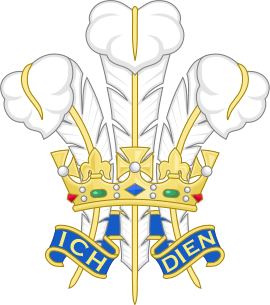Bollinger
Bollinger (French pronunciation: [bɔlɛ̃ʒe]) is a French Champagne house, a producer of sparkling wines from the Champagne region. They produce several labels of Champagne under the Bollinger name, including the vintage Vieilles Vignes Françaises, Grande Année and R.D. as well as the non-vintage Special Cuvée. Founded in 1829 in Aÿ by Hennequin de Villermont, Paul Renaudin and Jacques Bollinger the house continues to be run by members of the Bollinger family. In Britain Bollinger Champagnes are affectionately known as "Bolly".
| Bollinger | |
|---|---|
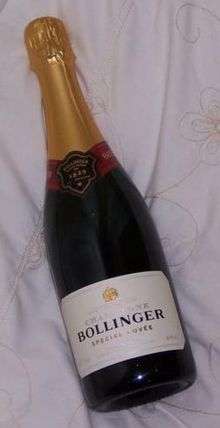 | |
| Wine region | Ay, Marne |
| Appellation | Champagne (wine region) |
| Cases/yr | 100,000 |
| Known for | Vieilles Vignes Françaises and R.D. (prestige) Grande Année and Grande Année Rosé (vintage) Special Cuvée (non-vintage) |
| Varietals | Pinot noir, Chardonnay, Pinot Meunier |
| Website | www.champagne-bollinger.fr |
History
Bollinger has roots in the Champagne region dating back to 1585 when the Hennequins, one of the Bollinger founding families, owned land in Cramant. Before the Bollinger house was founded, in the 18th century the Villermont family practised wine making, though not under their family name. In 1750, Villermont settled in the location 16 rue Jules Lobet, which would eventually become the head office for Bollinger.
In 1803 Jacques Joseph Placide Bollinger was born in Ellwangen, in the kingdom of Württemberg. In 1822, he moved to the Champagne region and began work at the Champagne house of Muller Ruinart, which no longer exists. Many other German nationals came to settle in the Champagne region, including Johann-Josef Krug and the Heidsiecks, who founded a house that would become Charles Heidsieck, Piper Heidsieck, Heidsieck & Co Monopole, Veuve Clicquot and others.
The Champagne house Renaudin Bollinger was founded on 6 February 1829 in Aÿ by Hennequin de Villermont, Paul Levieux Renaudin and Jacques Bollinger. The partners agreed that the Villermont name would not be used on the labels, hence the house name Renaudin Bollinger. Starting when Jacques Bollinger married Charlotte de Villermont, the house has been managed by the Bollinger family. Even though Paul Renaudin passed without an heir to his name, the label did not become solely Bollinger until the 1960s.
Founder Jacques Joseph Bollinger married Charlotte de Villermont. The couple had a daughter, Marie, who had two sons Joseph and Georges. These sons took over the company in 1885 and began expanding the family estate by purchasing vineyards in nearby villages. The sons also developed the image of the brand, such as when Bollinger received a Royal Warrant in 1884 from Queen Victoria.
Expansion under Lily Bollinger
In 1918 Jacques Bollinger, the son of Georges, took over the company. Jacques married Emily Law de Lauriston Boubers, known as "Lily". Jacques further expanded the facilities by building new cellars, purchasing the Tauxières vineyards, and acquiring the assets of another Champagne house on Boulevard du Maréchal de Lattre de Tassigny—where Bollinger's offices are presently located.
When Jacques Bollinger died in 1941, Lily Bollinger took over. Lily expanded production through the purchase of more vineyards, but is better known for traveling the world to promote the brand. Lily was well-publicized in the Champagne region, leaving several noteworthy quotes.
I drink it when I’m happy and when I’m sad. Sometimes I drink it when I’m alone. When I have company I consider it obligatory. I trifle with it if I’m not hungry and drink it when I am. Otherwise, I never touch it—unless I’m thirsty.[1]
Lily managed Bollinger until 1971, when her nephews Claude d'Hautefeuille and Christian Bizot succeeded her.
Modern day

Bollinger was modernized under the direction of Claude d'Hautefeuille, who acquired additional vineyards and developed the brand internationally. Following Claude, his cousin Christian Bizot took over the Bollinger house. In addition to expanding the world distribution of Bollinger, Bizot developed a Charter of Ethics and Quality in 1992. Since 1994, Ghislain de Mongolfier has managed Bollinger. A great-grandson of the founder, Mongolfier has also served as president of the Association Viticole Champenoise since 2004, after leading the Commission of Champagne for 10 years.
The winemaker has also used the popular James Bond film series as a marketing device. In the 1973 film Live and Let Die, James Bond (played by Roger Moore) is heard asking for a bottle of Bollinger after entering his hotel. In the 1985 film A View to a Kill, James Bond recognizes the champagne served at the top of the Eiffel Tower as "Bollinger, [19]75." In the 1987 film The Living Daylights, James Bond (played by Timothy Dalton) delivers a gift basket to General Koskov who, seeing the champagne, exclaims "Bollinger R.D....The Best!" In the 2002 film Die Another Day, James Bond (played by Pierce Brosnan) escapes from a British intelligence ship by jumping into the water, and immediately after he enters a 5 star hotel, still soaking wet, Bond is heard asking for a bottle of 1961 Bollinger. In The World Is Not Enough, James Bond (Pierce Brosnan) beds the female lead alongside an iced bottle of Bollinger. In the 2006 film Casino Royale, James Bond (played by Daniel Craig) also requests a bottle of Bollinger. There is also a bottle in his car at the end of the car chase at the start of GoldenEye.
Wines
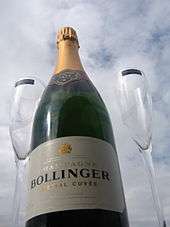
Bollinger is one of the last remaining independent Champagne houses. Family-managed since 1889, Bollinger maintains more than 150 hectares of vineyards. It currently produces the following sparkling wines:
- Special Cuvée (non-vintage): The Bollinger house style. This Champagne blend uses grapes from a given year, with the addition of reserve wines. Champagne author Tom Stevenson describes the house style as "classic, Pinot-dominated Champagnes of great potential longevity and complexity" which "tends to go toasty."[2] The blend includes up to 10% reserve wines, which may be up to fifteen years old. This gives the special cuvee complexity and structure. Special Cuvée are aged in the lees for at least 5 years before release. (Composition: 60% Pinot noir, 25% Chardonnay, 15% Pinot Meunier.)
- Grande Année (vintage): When Bollinger believes there is an exceptional harvest, they will produce their prestige Champagne Grande Année ("great vintage") designed to express the character of the vintage. The house will select the best wines, cru by cru, to produce Grande Année. This Champagne is also available as a Rosé. The wine spends five years on its lees and is aged in bottle under cork, instead of crown seal. (Composition: 65% Pinot noir, 35% Chardonnay.)
- R.D. (vintage): This blend is a logical extension of the Grand Année blend, taken further by extending the aging on lees. R.D. spends at least eight years on its lees, and is also, like the Grand Année, aged under cork, not crown seal. R.D. is a registered trademark of Bollinger which stands for récemment dégorgé ("recently disgorged"). In the mid-1990s, Bollinger sold Année Rare which was an R.D. that had gone under even longer aging on the lees. The disgorgement date is given on the back label. Michael Broadbent has noted that there is variation between R.D. Champagnes of the same year with different disgorgement dates. The 1981 R.D. is unique in that there was no Grande Année produced from that vintage.
- Vieille Vignes Françaises (vintage): Regarded as Bollinger's prestige cuvee, this blanc de noirs is made in small quantity with wine from two small plots of ungrafted rootstock planted in low density (3000 vines per hectare). The English wine writer Cyril Ray suggested the idea of using the ungrafted vines to produce a separate wine to Madame Bollinger in the 1960s.[3] The first vintage was 1969. The total area of vines used for this rare Champagne is less than half a hectare. Vieille Vignes refers to how the vines are trained rather than the age of the rootstock. The low-density vineyards, Clos St-Jacques in Aÿ and Chaudes Terres in Aÿ, are severely pruned, and thus produce 35% less juice per vine, creating a "super rich wine."[4] In 2005, phylloxera destroyed the third vineyard used for this wine, Croix Rouge in Bouzy. Bottles are numbered and the annual production of the ungrafted plots has varied between 3000 and 5000 bottles.[5]
- Coteaux Champenois La Côte aux Enfants (vintage): This still red wine is produced from grapes grown on the south-facing slope of the 100% echelle vineyard, the Côte aux Enfants in Aÿ.[6]
Reserve wines
Every harvest, Bollinger saves some wines from the grand crus and premier crus for reserve wines. The reserves are bottled in magnums with cork, under light pressure and aged for five to fifteen years. Bollinger maintains a large library of more than 750.000 magnums, saved cru by cru, year by year. Bollinger's reserve wine system is unique in Champagne, and the house believes it contributes to the style of the Special Cuvée.
Production
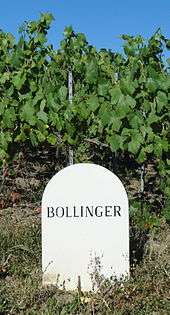
Bollinger is fermented in oak barrels, making the Champagne well-suited to aging in the cellar. At harvest, only the first pressing is used, the cuvée, unless the vintage is of particularly high quality, when a second pressing of Chardonnay will be used. Bollinger sells the second pressing, the tailles.
Bollinger utilizes two pressing houses (Louvois and Mareuil sur Aÿ) to ensure a short distance between harvest location and pressing. When possible, grapes purchased from growers are pressed by the house. When the pressed wine arrives, the Bollinger cellar master analyzes the musts for quality, discarding and selling off those that do not meet the house standards.
The first fermentation is done cru by cru, variety by variety, preserving many of the unique characteristics of the vines location. Bollinger is one of the few Champagne houses to do some first fermentation in oak barrels. Wines that will not hold up to first fermentation in wood are vinified in vats. Bollinger Champagnes usually undergo malolactic fermentation. The Grande Année 1995 did not undergo malolactic fermentation. Bollinger uses only traditional yeast, having decided that new generations of yeasts (agglomerated yeasts and encapsulated yeasts) do not produce satisfactory Champagne.
Vintage wine, including all wine to be used in a Grande Année, is fermented in small oak barrels, sorted according to origin and variety. Both oak and stainless steel are used for non-vintage wine. Bollinger employs the last cooper in Champagne. The oak barrels are all at least four years old, avoiding the transfer of tannins to the wine. The wines are only lightly filtered.
All Bollinger Champagne spends a long time on its lees, contributing to the complex flavour of the wine. Though appellation d'origine contrôlée rules only require 12 months on lees for non-vintage Champagne and for vintage (NV wines, 15 months from tirage to release and vintage wines must be kept for 36 months from tirage to release), Bollinger ages their non-vintage wines three years, and the vintage wines five to eight years. Furthermore, the Grande Année and R.D. Champagnes are riddled by hand.
At disgorgement, Bollinger wines are given a low dosage, to maintain the balance and flavour of the wine. The company uses 6–9 grams of sugar per liter for the Special Cuvée and La Grande Année. The extra-brut R.D. is dosed between 4 and 5 grams. After dosage, the wines are aged an additional several months, resting for a minimum of three months before shipping.
Bollinger Champagnes are shipped ready to be consumed, though they do have the capacity to age. Wine writers such as Robert M. Parker and Michael Broadbent have noted differences between Grande Année and R.D. of the same vintage.
Grape supply
Bollinger owns nearly 160 hectares of vines, producing more than 60% of its supply. The vines are predominantly Pinot noir, specifically clone 386. Bollinger believes this clone ensures good quality as well as highlighting characteristics of the various terroirs.
The vineyards also include some rare ungrafted French vines from before the phylloxera epidemic. Bollinger owns vines in the heart of the Champagne region, including the crus of Aÿ, Bouzy and Verzenay.
List of Villages with size of holding and rating[7]
- Avenay: 15 hectares of 93% echelle.
- Aÿ: 22 hectares of 100% echelle
- Bisseuil: 5.4 hectares of 93% echelle
- Bouzy: 0.25 hectares of 100% echelle
- Champvoisy: 17 hectares of 84% echelle
- Cuis: 21.15 hectares of 95% echelle
- Grauves: 6.6 hectares of 95% echelle
- Louvois: 15.7 hectares of 100% echelle
- Mutigny: 3.95 hectares of 93% echelle
- Tauxières-Mutry: 17.95 hectares of 99% echelle
- Verzenay: 17 hectares of 100% echelle
Corporate structure
The holding company for Bollinger is Société Jacques Bollinger, whose holdings in France also include Ayala Champagne, Maison Chanson in Burgundy, Langlois-Chateau in the Loire valley and Delamain in Cognac.[8] In Australia, Société Jacques Bollinger has invested in the Tapanappa Winery located in the Wrattonbully wine region in Australia.[9] Other partners in the Tapanappa Winery are Jean Michel Cazes of Château Lynch-Bages and Brian Croser, formerly of Petaluma Winery.[10]
See also
- List of Champagne producers
References
- Stacy Slinkard. "Champagne Quotes". About.com. Retrieved 2015-11-30.
- Stevenson, Tom. Christie's World Encyclopedia Of Champagne & Sparkling Wine. San Francisco, California: Wine Appreciation Guild. pp. 54–55. ISBN 1-891267-06-X.
- Cyril Ray, Bollinger, tradition of a Champagne family, 2nd ed. 1982 Heinemann
- Stevenson, Tom. Christie's World Encyclopedia Of Champagne & Sparkling Wine. San Francisco, California: Wine Appreciation Guild. pp. 56–57. ISBN 1-891267-06-X.
- Eric Asimov (2006-06-14). "A Champagne True to Its Roots". The New York Times. Retrieved 2015-11-30.
- Tom Stevenson, Champagne, Sotheby's Publications, 1988 at p. 201.
- Tom Stevenson, Champagne, Sotheby's Publications, 1988, pp. 200–201.
- "Jacques Bollinger Company - Langlois-Chateau". Retrieved 2015-11-30.
- "Our Story: The Evolution of Tapanappa". Tapanappa Wines Pty Ltd. Retrieved 2015-11-30.
- "Brian Croser, Petaluma and Tapanappa, part three". Retrieved 2015-11-30.
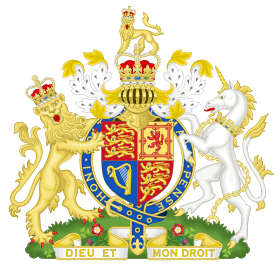
.svg.png)

